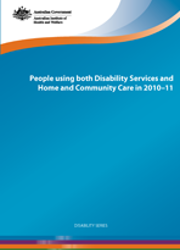Summary
Many people with disability, or the frail elderly, need specialised services to enhance or maintain a reasonable quality of life, or to maintain their independence for as long as possible. This report examines the characteristics and service use of people who accessed two major sets of services in 2010-11: Disability Services (DS) and the Home and Community Care program (HACC). This analysis can inform the development and monitoring of the services to meet the needs of these groups of people, especially in the context of implementing the National Disability Insurance Scheme (NDIS). Key findings are summarised below.
Number of people who used both DS and HACC services in the same year
In 2010-11, around 54,800 people were known to have used both DS and HACC services. A total of 1.2 million people received services from the DS program and/or the HACC program, including 259,400 who used only DS and 879,500 who used only HACC services.
People using both service programs required higher, more complex and diverse supports
Compared with users who accessed only DS, users of both service programs were older and more likely to have had disability from an early age. They were also more likely to have activity limitation/participation restrictions that required higher level, complex and diverse supports; to have an informal carer and be cared for by an older carer; to not participate in the labour force; and to rely on the Disability Support Pension as their main source of income.
Compared with users who accessed only HACC services, a higher proportion of users of both service programs were younger than 65 and lived with family. They were more likely to have a carer, and their carer was more likely to be female, a parent, and co-resident.
People using both service programs were more extensive users of the two programs
Users of both service programs received substantially more DS support than those who accessed only DS, in terms of type of care and quantity of care. The four service groups accessed more highly were accommodation support (24% versus 12%, respectively), community support (63% versus 41%), community access (31% versus 17%) and respite (26% versus 9%). Compared with users who accessed only HACC services, a greater proportion of users of both service programs received most of the available HACC services and usually used more of each service.
People using both service programs relied on these programs' complementary services
A wide range of combinations of services from DS and HACC programs were delivered to users of both programs. These combinations included services similar to both programs and services specific to only one of them. For example, a majority (62%) of those who used both service programs used 2 or more types of HACC services to meet their needs, including 14% who used 5 or more. Among users of both programs, 37% of users of DS respite care also received HACC respite care services, one-quarter of DS users receiving community support services also received HACC allied health services, about one-fifth of DS users receiving accommodation support also received HACC domestic assistance, and one-quarter received HACC nursing care at home. This pattern of service use indicates the important role played by the DS and HACC programs in 2010-11 in meeting the high support needs of users of both programs, in terms of quantity and type of care.
Preliminary material: Acknowledgments; Abbreviations; Symbols
1 Introduction
- Background to the project
- Policy environment
- Analysis undertaken
2 Data and methods
- Data
- Methods
3 Number of people who used both DS and HACC services
- Number and age profile of service users
- Overview of users aged under 65
4 DS user profile: users of both programs compared with DS only users
- Age and sex
- Disability groups
- Support needs for participation in life areas
- Living arrangements and informal care
- Labour force participation and income
- Individualised funding arrangements
- Aboriginal and Torres Strait Islander people
5 HACC user profile: users of both programs compared with HACC only users
- Age and sex
- Living arrangements and informal care
- Country of birth
6 Disability service use: comparisons between users of both programs and DS only users
- Service groups
- Service types
- Combinations of services used
7 Users of both DS and HACC: combinations of service use
- HACC service use by people who use both programs
- Combinations of DS and HACC services used
8 HACC service use: comparisons between users of both programs and HACC only users
- Assessment
- HACC service use by people aged under 65
- HACC service use by people aged 65 or older
- Provision of aids and equipment
9 Discussion
- Flexible delivery of DS and HACC programs helps support individual needs
- Complementary nature of combined DS and HACC service provisions
Appendixes
Appendix A: Data and technical notes for Chapter 7
Appendix B: Supporting tables for chapters 3-8
End matter: Definition of service types; References; upport for informal carers of people with high-level support needs; List of tables



